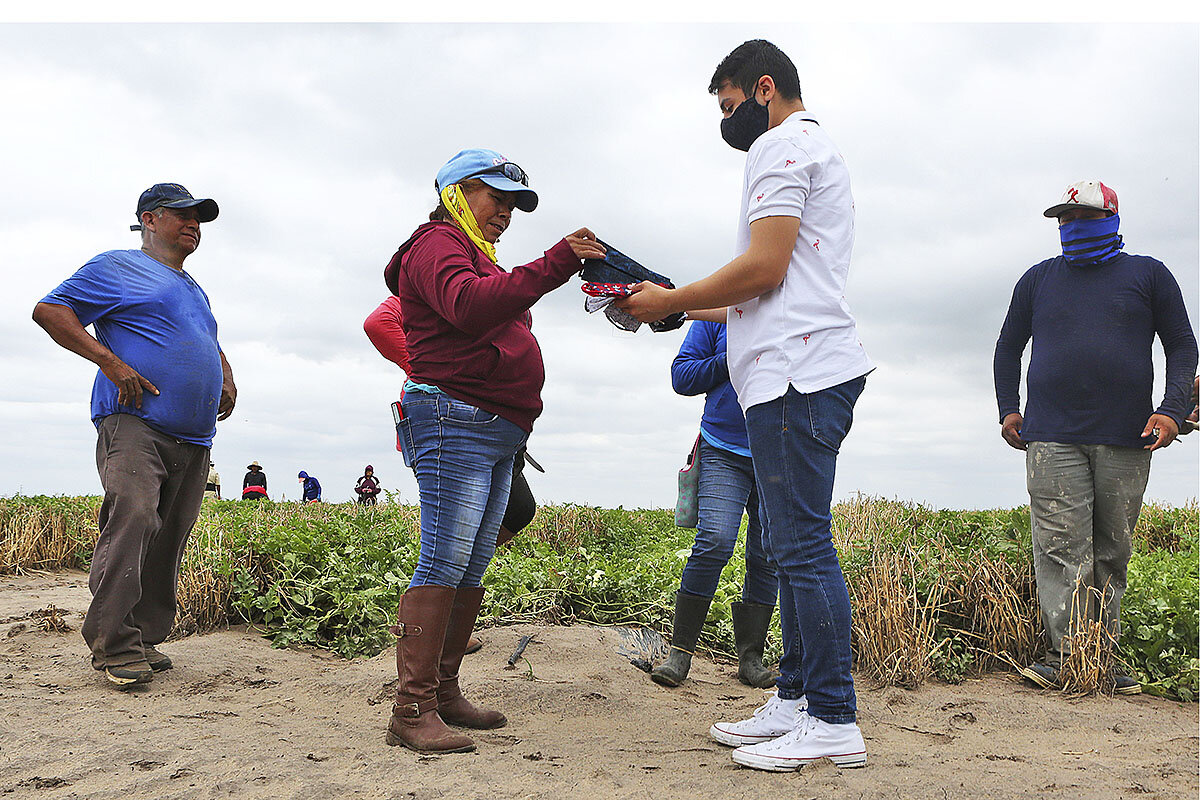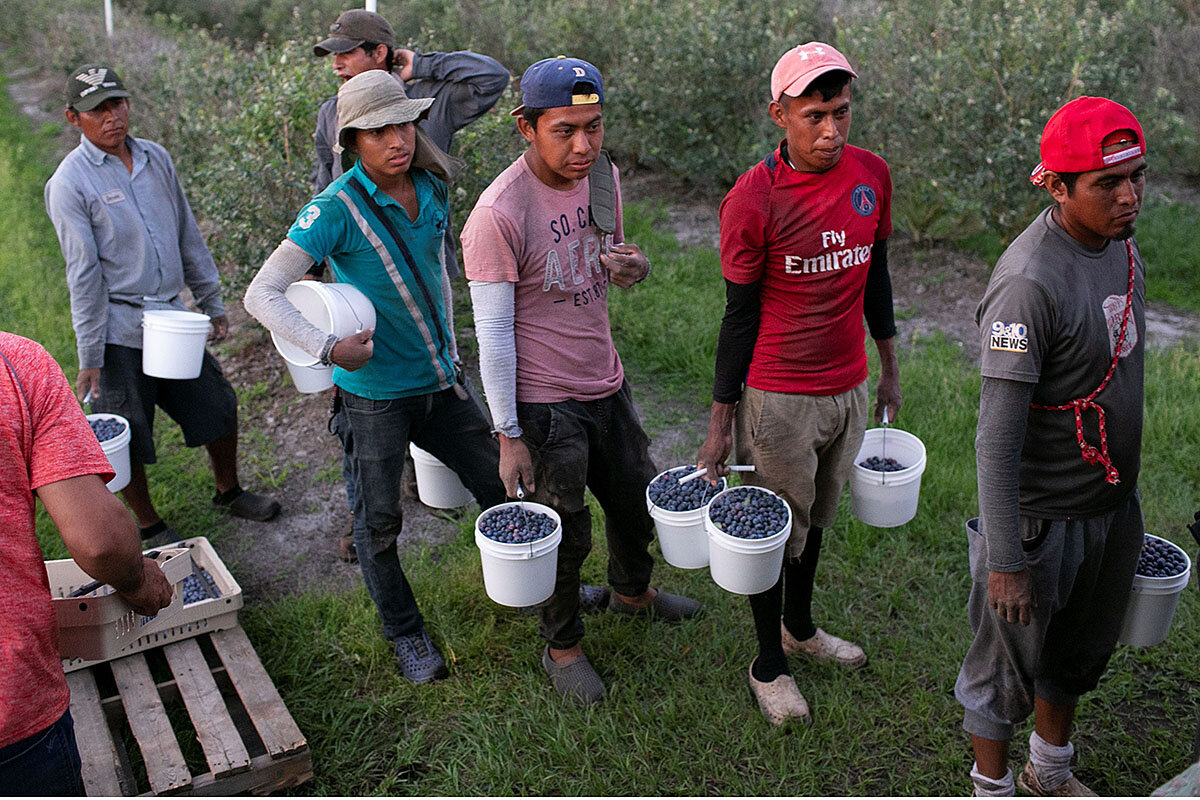For migrant farmworkers, coronavirus adds new burdens
Loading...
| Shelby, Michigan
When Yesenia Madrigal and her family planned their annual trip from Florida to Oceana County, Michigan, they thought their travels as a seasonal farmworker family would proceed as in years past. They would arrive in time for the May asparagus harvest, take a short break, and then plunge into the tree fruit season before returning to Florida. Their children would be able to go to schools and Head Start programs while she, her husband Lazaro, and 22-year-old son Hector Vasquez were earning money.
Not so in 2020. COVID-19 and the resulting stay-at-home orders provided a one-two punch of setbacks to the Madrigal family and added extra pressure to the migrant farm labor system for workers and employers alike.
“When I first heard about [COVID-19], I thought, ‘OK, the kids won’t be in school and that’s a big deal.’ I have a 2-year-old and he couldn’t go to day care. So I would have to stay home and that means I wouldn’t be able to go to work,” Ms. Madrigal says.
Why We Wrote This
The United States relies on 2.4 million farmworkers to harvest everything from blueberries to lettuce. This year they’re confronting extra risks tied to the COVID-19 pandemic.
There are an estimated 2.4 million seasonal farmworkers in the United States, including permanent residents, “follow the crop” workers such as the Madrigal family, and workers who come to the U.S. from other countries. Those workers come from Mexico, Central America, Jamaica, and as far away as South Africa.
In the current pandemic, even as food-industry workers such as grocery clerks have gained public attention for providing “essential” services, seasonal farmworkers remain largely out of the limelight. They’re tasked with picking much of America’s food, while facing heightened challenges and health risks due to the coronavirus.
Editor’s note: As a public service, all our coronavirus coverage is free. No paywall.
And they are doing this difficult work for low pay. Average pay for farmworkers in 2019 was – 60% of what U.S. production and nonsupervisory workers outside of agriculture averaged, according to analysis by the Economic Policy Institute. For the rising share who come to the U.S. on a guest-worker basis, the federally set minimum ranges by state from $11.71 to $15.83 an hour, after a proposed reduction was averted this spring.
“Essential farm workers continue putting food on our tables, but too often can’t feed their own families,” United Farm Workers President Teresa Romero said in a . “We will keep pushing for urgently needed remedies,” she said, such as paid sick leave regardless of the size of an employer.
Here in west Michigan’s Oceana County, an early May freeze added an extra layer of distress to both growers and farmworkers. The freeze forced asparagus growers to cut off and discard the damaged spears and then wait for them to grow again to the height required for sale to the fresh market. The delay in turn caused an income gap for the labor crews.
Eroded savings and added duties
The combination of the late start of harvest, the pandemic, and a delay in the arrival of unemployment benefits – which had still not arrived as of June 10 – wrecked the careful financial plans put in place by the Madrigal family that normally guide the transition as they head north. After their savings were eroded, they were forced to sell one of their vehicles.
From there, it has been a waiting game until an overburdened state of Michigan unemployment system could provide benefits. Until children could return to schools and day-care facilities, Ms. Madrigal, a U.S. citizen, had to care for her sons who are too young to work in the fields and keep them occupied while fending off boredom.
“Thank God they’re good kids,” she says. “I keep them busy. My 2-year-old is having a hard time with speech, but with me being home, I have been helping him with that. I give my boys jobs and things to do throughout the week. But it’s not the same as being in school.”
As harvest season ramps up nationwide in a time of pandemic, worker safety becomes an even more pressing concern. Because of food safety regulations, some workers were already required to wear personal protective equipment (PPE), including masks and gowns, before COVID-19. Social distancing is easier to achieve during outdoor work, depending on row spacing and the distance between fruit trees and bushes. Social distancing becomes more challenging indoors, where areas such as packing and inspection lines traditionally have people working in close proximity.
For seasonal farmworker service provider organizations, 2020 has meant finding new ways to help clients. Telamon, a nonprofit that provides educational services to farmworker families, has not yet gained governmental approval to open its 13 Head Start centers.
Donald Kuchnicki, workforce and career services director for Telamon in Michigan, said the organization has been getting ready for the day the centers can reopen. Staff have been busy ordering supplies, cleaning and sanitizing, and establishing best practices to monitor for the virus.
“We’ve been reaching out to the farmworker families as they return to the area. It’s really been a struggle with the families that want the centers to be open, but we have to be measured in our approach,” Mr. Kuchnicki says.
The virus has introduced a stark risk assessment into the lives of workers and their families, as they balance the need for income against the risk of a serious illness that .
“If you’re feeling sick, are you going to let someone know or are you going to keep that to yourself? If you test positive, the last thing you want to do is bring attention to yourself,” Mr. Kuchnicki says.
Farm businesses such as the Scaroni Family of Companies, which operates farms in the western United States, say they are following Centers for Disease Control and Prevention guidelines on social distancing and PPE. The farms instruct their workers on how to use masks and gloves and on proper sanitation procedures in the fields and in housing. In-field leafy green harvesting and packing machines now include plastic barriers between workers.
Uncertainty for farmers
The industry is grappling with uncertainty on many fronts, from shifting demand (as restaurants curtailed operations) to an already tight supply of agricultural workers. In some cases, workers have been unable to come to the U.S. due to problems obtaining visas and restricted air travel. Some farmers, meanwhile, have adjusted their crop mix this year to be less labor-intensive.
“For the most part, it seems that as long as they can get workers, they’re going to try and harvest the crops they’ve historically produced,” says Michael Marsh, executive director of the National Council of Agricultural Employers. “Farmers are very innovative in finding solutions. They’ve rolled with this and done as well with it as they can.”
The workers and their allies are also trying to cope, day by day.
“We want to open up the Head Start centers when appropriate, but we want to make sure it’s in the best interests of the families,” Mr. Kuchnicki says, noting that services will probably be offered in smaller classroom groups. “There are so many moving pieces that it makes the situation challenging.”
Editor’s note: As a public service, all our coronavirus coverage is free. No paywall.





